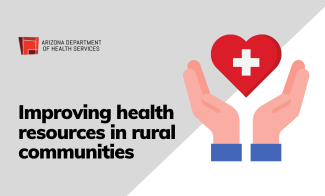 Fourteen percent of the U.S. population lives in rural areas, in Arizona that number is much higher at 25%, likely due to the landscape and environment we live in.
Fourteen percent of the U.S. population lives in rural areas, in Arizona that number is much higher at 25%, likely due to the landscape and environment we live in.
USDA Economic Research Service found that residents living in the United States’ most rural counties may have more difficulty finding and using health care services in comparison to their counterparts in metropolitan areas or more rural counties with population hubs. According to the 2019 Arizona State Health Assessment (SHA), one-quarter of Arizonans live in rural counties. Arizona continues to experience a disproportionate distribution of primary care providers, especially in these rural areas. Mirroring national trends, the 2019 SHA reported the ratio of population to Primary Care Providers (PCPs) in urban areas is 2,407:1 compared to 3,896:1 in rural Arizona.
Several initiatives across ADHS are focused on strengthening the workforce in Arizona’s most rural communities. This includes the Arizona State Loan Repayment Programs (SLRP), aimed at promoting the recruitment and retention of health care professionals by repaying their qualifying educational loans. Participating health care professionals are required to complete a two-year commitment by providing primary care services in federally designated Health Professional Shortage Areas (HPSA) or Arizona Medically Underserved Areas (AzMUA). Almost 40% of Arizonans live in a HPSA, with a need of 665 practitioners to remove that federal designation. There are 82 AzMUAs, 12 of those AzMUAs are within tribal nations’ land. Incentivizing primary, dental, and mental health care providers offers one option that focuses limited resources on communities with the greatest need for health care services. The SLRP application period for Health Care Professionals opens April 17, 2023.
The Arizona Surge Line was active for two years during the COVID-19 pandemic. Nearly 10,000 patients with COVID-19 and load-leveling hospitals were moved to postpone crisis standards of care in the state. With the end of the declared state of emergency in Arizona, the Arizona Surge Line closed in the spring of 2022. However, this opened the door for another possibility – Arizona Resource Equity and Access Coordination Hub (AZ REACH). Launched in December 2022, AZ REACH is a support model for hospitals classified as critical access, Indian Health Service (IHS), and tribally operated P.L. 93-638. Hospital staff may use this voluntary, free 24/7 service to coordinate acute medical care transfers. Lessons learned from the pandemic have been foundational to the success of AZ REACH. Within three months, 1,000 patients have been transferred to eligible hospitals. AZ REACH streamlines the transfer process by facilitating calls for placement, connecting practitioners, and following through on placement progress, allowing referring facility team members to focus on care.
The Arizona Health Improvement Plan’s (AzHIP) Rural & Urban Underserved Health priority is focused on increasing the number of healthcare providers in rural areas. This starts with building a diverse healthcare workforce. While the SLRP offers one option, it’s not enough to infuse the much needed workforce into rural communities. Reducing financial and other barriers ensures that underserved students in health professions education programs have the opportunity to complete their training.
The healthcare workforce must be representative of the communities they serve. Not only does this grow local talent, it also builds trust between patients and providers. In addition, the curriculum used to train health professionals must address community needs while also considering the needs of tribal communities and cultural understanding of the community impacted. These programs and initiatives alone won’t solve Arizona’s long standing crisis, but they do allow for space to understand and address health disparities uniquely impacting rural and underserved Arizonans.










